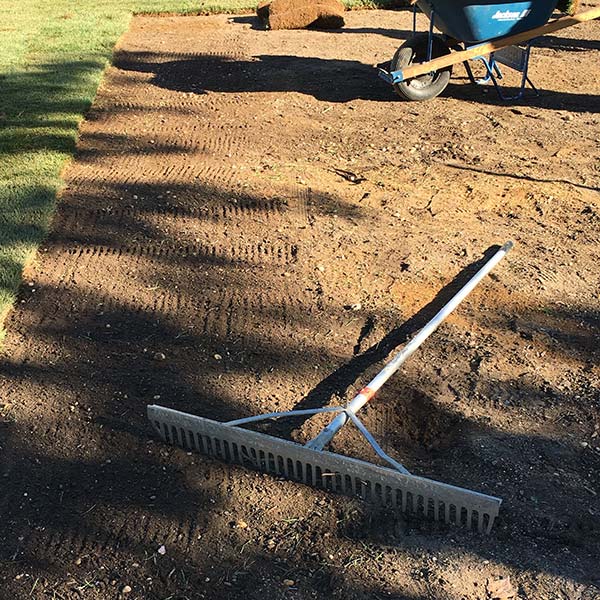SOIL PREPARATION
Remove all building waste, rocks, old lawn & weeds.
Any living weeds left behind will sneak up between the new turf joins. Dead weeds/lawn will hinder the roots of the new turf from finding the soil underneath and will prevent your new turf from establishing evenly.
You will find that if you already have couch or kikuyu in your yard, it is very hard to permanently remove. We recommend spraying with say Roundup, as you will never dig up all the runners.
Dig up or turn over soil and consider introducing new soil.
Introducing new soil will pay for itself with the remarkable variance on how well the turf does.
Spread on appropriate soil conditioners if desired i.e. for acidic soils add lime, for heavier clay soils add gypsum, for sandy soils simply mix in small amounts of organic material.
Use a Rotary hoe or a shovel to turn the soil over.
If you are adding organic material – make sure that you only use a small percentage and mix it in well with the soil. If the turf is laid directly onto organic material, the roots will not be able to get to the soil and will die. Organic material is porous and heats up really easily.
Make sure that your soil is finely broken up. If the slabs/rolls of lawn are placed upon clods of dirt, it create air pockets. Air pockets prevent the roots from holding moisture.
Level the surface.
Eliminate drainage problems by making the soil drain away from the house.
Allow for the height of the turf along paths – for Santa Ana Couch, leave around 20mm. This will allow the leaf of the grass to be above the path.



LAYING THE TURF
During warmer weather in Summer, please lay the turf immediately: dampen down the earth prior to laying the turf, then lay a small section of turf, water it, then lay the next section. Soak the turf initially then keep the soil below the turf damp. You will need to water the turf morning and night for the first 3 to 4 weeks.
Lay the turf within a couple of hours of delivery.
For best results your new instant turf should be installed as soon as it is delivered. Turf laid a couple of days after delivery in summer might not survive. In the cooler weather it will take longer to establish and some areas might die back (Couch grass will eventually regrow in these spots).
Don’t let the slabs/rolls of turf dry out.
On hot days the unlaid stack of turf should be in the shade and sprinkled with water – do not soak, just a light misty spray.
Apply a ‘lawn starter’ fertiliser.
Spread your lawn starter fertiliser evenly over the area and lightly rake or water in (If you forget to put it under, it is not crucial and it may be placed over the top).
We will provide a free start up fertiliser for orders over 30 square metres.
Dampen down the area where you are going to lay the turf.
Do not lay turf onto dry soil, especially in the warmer months. It is ideal to dampen down the area about 4-12 hours before you lay the turf. You do not want it muddy when you go to lay the turf as it makes a messy uneven job and harder work.
Start laying.
Remove all the plastic net wrapping from around the turf.
You should start laying turf away from your stack of turf if possible, to avoid walking continually over the newly laid turf.
Just remember that each roll of turf can be up to 20kg in weight, so if you wish to lay a large amount of turf – find some friends! It is tough going on your own.
Allow plenty of time to lay the turf. If you are unable to finish the job on the day, just dampen down the turf yet to be laid and place it in the shade if possible. Don’t put a tarp or a plastic cover over the turf, as the turf will sweat. Find something that will breathe ie. old wet bedsheet or wet shadecloth.
Use a brickwork pattern.
Choose your straightest and longest edge; start with rolling your lawn out without pulling or stretching the turf, pushing the edges together, staggering the joins in a brickwork pattern. You may need to peg grass on sloping areas to prevent movement.
Avoid gaps as this provides a perfect environment for weeds to grow.
Avoid overlapping the turf as the roots will dry out and the turf will die.
Avoid leaving narrow strips.
Your turf will naturally die back on the edge of the roots after being harvested. Strips of turf at the outer edges of the area may struggle to retain moisture, especially if not top-dressed.


